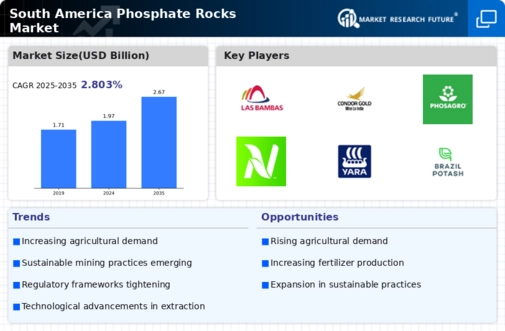The competitive insights of the South America Phosphate Rocks Market reveal a dynamic landscape characterized by a diverse range of companies that contribute to the region's agricultural and industrial sectors. The market has been increasingly influenced by the growing demand for fertilizers, which are essential for enhancing crop yields and ensuring food security. As South America continues to be a significant player in global agriculture, the phosphates derived from phosphate rocks have become crucial for boosting the productivity of arable lands.
The competitive environment features various key players who leverage their geographical advantages, local expertise, and technological innovations to capture market share. The overall health and potential growth of this market appear to hinge on factors such as regulatory frameworks, environmental concerns, and advancements in extraction and processing technologies, alongside the adaptability of companies in facing these challenges. Minera Las Bambas has established a notable presence in the South America Phosphate Rocks Market, primarily due to its strategic resource management and commitment to sustainable practices.
The company's operations benefit from its robust mining capabilities and technical expertise, allowing for efficient extraction processes that minimize environmental impact. Additionally, Minera Las Bambas is recognized for its focus on quality control and product reliability, which helps in building customer trust and long-term relationships within the market. The company's strengths also lie in its well-established supply chain networks, enabling seamless distribution to serve both local and regional agricultural needs.
By optimizing its production processes and adhering to environmental standards, Minera Las Bambas has positioned itself as a competitive player, driving advancement in phosphate rock utilization within the agricultural framework of South America. Condor Gold operates within the South America Phosphate Rocks Market, leveraging its innovative approaches to enhance the availability of phosphate-based fertilizers. The company provides a range of key products and services tailored to meet the needs of local agriculture, contributing to the overall growth of the sector in the region.
Condor Gold's market presence is strengthened by its emphasis on research and development, fostering new methodologies for phosphate resource extraction that align with sustainability goals. The company actively seeks strategic partnerships and potential mergers or acquisitions to bolster its capabilities and market reach, facilitating an expanded product offering. With a clear focus on delivering quality phosphate solutions, Condor Gold continues to enhance its competitive edge by addressing the demands of farmers and agricultural stakeholders in South America, thereby solidifying its role in the phosphate market landscape.



















